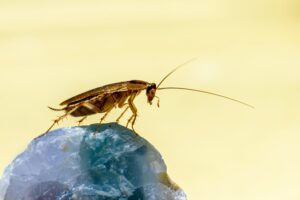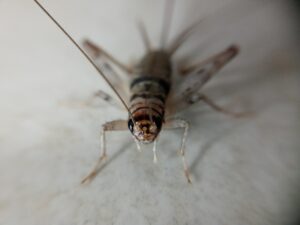Cockroaches are commonly thought of as pests, but did you realize they may also be dangerous to your health?
These insects are known to transport and transmit infections that can cause a variety of ailments in humans. So, it’s not just unpleasant to see a roach crawling through your home, but they are actually more dangerous than other pests such as bed bugs.
In this post, we’ll look at the link between cockroaches and food-borne pathogens and talk about how you can protect yourself and your family from these harmful bacteria.
Table of Contents

Cockroaches and Food Poisoning
Cockroaches can transport and spread food-borne illnesses because they scavenge for food in the garbage, sewers, and other unclean areas. They can carry hazardous bacteria and other organisms on their legs and bodies, then transfer these diseases to food or contaminate surfaces in food preparation areas when they crawl over them.
Roaches love to hang out in human homes because there is always an abundance of food and plenty of places to hide. This is especially true during winter when roaches and other pests seek shelter in your warm home.
When bacteria the roaches leave behind are consumed, they can produce a variety of food poisoning symptoms such as nausea, vomiting, stomach cramps, and diarrhea. Food poisoning can cause major consequences such as renal failure, dehydration, and even death in extreme cases.
It is crucial to remember that not all cockroaches transmit food-borne infections and that cockroaches do not cause all cases of food poisoning. The presence of cockroaches in a food preparation area, on the other hand, is a clear symptom of inadequate hygiene and should be treated quickly to prevent the spread of potentially hazardous microorganisms.

As Eric S Donkor researches in his study:
“Food-borne disease is a widespread and escalating public health problem globally. About a quarter of the microorganisms isolated from cockroaches are food-borne pathogens including Escherichia coli O157:H7, Staphylococcus aureus, Bacillus cereus, Shigella dysenteriae, Salmonella enterica subsp. enterica serovar Typhi, Rotavirus, Aspergillus fumigatus, and Cryptosporidium parvum. Thus, cockroaches could be an important reservoir and mechanical vector of food-borne pathogens.”

What Are the Most Common Cockroach Diseases
Learn about the most common diseases that cockroaches can carry and spread to humans. Find out how to prevent and control cockroach infestations to protect your health and home.

How to Get Rid of Crickets
Discover the most efficient ways to get rid of crickets from your home and garden, and eliminate the pests from your home fast.

5 Best Traps to Get Rid of Moths for Good
Discover the best moth traps on the market and repel or completely get rid of moths faster and more efficiently.
Food Poisoning Symptoms Caused by Cockroaches
Food poisoning symptoms vary based on the organism involved, however, some frequent symptoms include:
- Vomiting and nausea
- Cramps and discomfort in the stomach
- Diarrhea
- Fever
- Headache
- Muscle pain
- Appetite loss
These symptoms can range from mild to severe, and they might emerge hours or days after eating infected food. Food poisoning can sometimes lead to more serious issues, such as renal failure, dehydration, and even death.
If you suspect you have food poisoning, get medical assistance as soon as possible. But even if you don’t have any symptoms yet but you do notice a few roaches in your home, deal with them as soon as possible with roach glue traps or call professional pest control.

What Are the Most Common Cockroach Diseases?
While not all cockroaches carry diseases, several species have been linked to a variety of disorders in humans.
The following are some of the most frequent cockroach-borne diseases:
- Salmonellosis is a kind of food poisoning caused by the bacterium Salmonella, which is frequently found in cockroach excrement. Diarrhea, fever, stomach pains, and vomiting are all symptoms.
- Dysentery is an intestinal infection caused by the bacteria Shigella, which is commonly carried by cockroaches. Symptoms include bloody or mucousy diarrhea, fever, and stomach discomfort.
- Cholera is a potentially fatal infection of the small intestine caused by the bacteria Vibrio cholera. This bacteria can be carried by cockroaches on their legs and spread to food and water sources. Watery diarrhea, vomiting, and muscular cramps are among the symptoms.
- E. coli infection is a gastrointestinal illness caused by the bacterium Escherichia coli (E. coli). This bacterium may be carried by cockroaches on their legs and spread to food and water sources. Diarrhea, stomach pains, and vomiting are common symptoms.
- Gastroenteritis is a broad word for stomach and intestinal inflammation. A number of infections, including those spread by cockroaches, can cause it. Diarrhea, vomiting, and stomach pains are among the symptoms.
How to Prevent Cockroaches from Spreading Diseases?
Here are some suggestions to keep cockroaches from transmitting disease:
particularly in the kitchen and food preparation areas. Cockroaches and other pests will find it less appealing as a result. You can always add some Diatomaceous Earth Powder with a long nozzle duster in areas that might have roaches as it’s a safe solution for your family and pets.
To keep cockroaches from foraging for food, keep food in sealed containers and dispose of rubbish on a regular basis. Keep the leftovers in the fridge and deal with the infestation as soon as possible.
Repair any leaks or plumbing issues that might supply cockroaches with a source of moisture. To keep cockroaches out of your home, seal any holes or gaps in the walls, flooring, or baseboards.
To control and remove cockroach infestations, use bait stations, traps, or pesticides.
It’s also crucial to maintain basic kitchen hygiene, which includes thoroughly washing your hands before handling food and frequently cleaning and sanitizing surfaces and equipment. This will aid in the prevention of the spread of hazardous infections, whether carried by cockroaches or not.